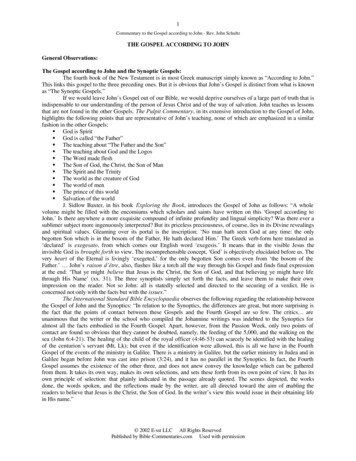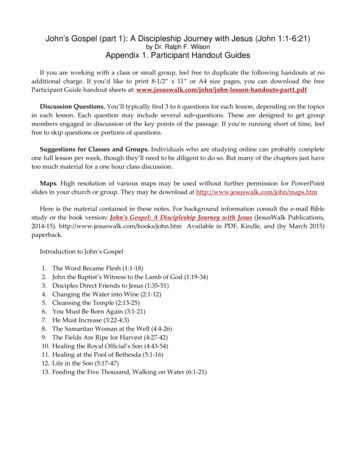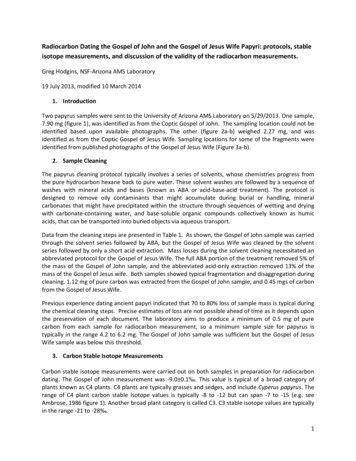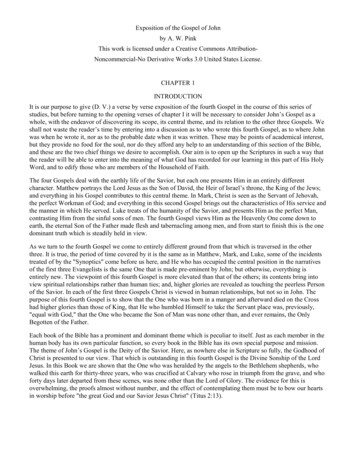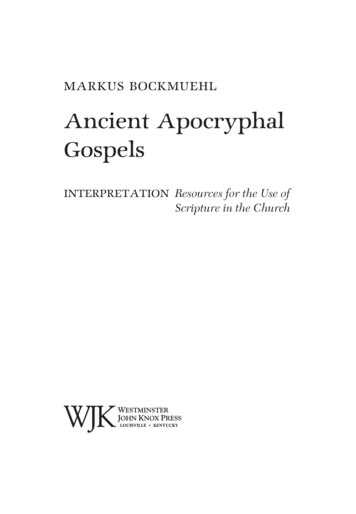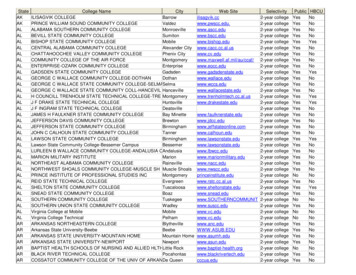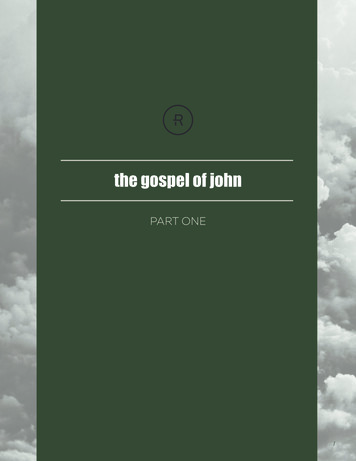
Transcription
the gospel of johnPART ONE1
the gospel of johnPART ONE // WEEKS 1–6“These are writtenso that you may believe thatJesus is the Christ, the Son of God,and that by believing you mayhave life in his name.”John 20:31For a great overview,watch the Bible Project video “John, Part 1 of 2” here:https://bibleproject.com/explore/john/#! 2020 by Redemption Church TempeAll rights reserved.Unless otherwise noted, all Scripture quotations are from the ESV Bible (The Holy Bible,English Standard Version ), copyright 2001 by Crossway, a publishing ministry of Good NewsPublishers. Used by permission. All rights reserved.Scripture quotations marked MSG are taken from THE MESSAGE, copyright 1993, 2002,2018 by Eugene H. Peterson. Used by permission of NavPress. All rights reserved. Represented byTyndale House Publishers, a Division of Tyndale House Ministries.2
Table of Contents4Introduction5How to Use this Study Guide6Conversational Prayer7Week One: The Word10Week Two: Among Us13Week Three: The Lamb of God16Week Four: Follow Me19Week Five: The Winemaker22Week Six: The Temple25NotesTable of Contents // 3
introductionThe Gospel according to John is an eyewitness account of the Good News about Jesus. Early churchtradition attributes the authorship of this gospel to the apostle John. Though John was in the smallinner circle of Jesus’s friends, he preferred to identify simply as “the disciple whom Jesus loved” (John20:21,24). His firsthand, front-row seat to the life of Jesus gives credibility to his words.John’s heart in writing this book was to bear witness to what he saw and heard as he lived and walkedwith Jesus. He states his purpose near the end of the book: “Now Jesus did many other signs in thepresence of the disciples, which are not written in this book; but these are written so that youmay believe that Jesus is the Christ, the Son of God, and that by believing you may havelife in his name” (John 20:30–31).First-century followers of Yahweh, like John and his friends, were not only familiar with theprophecies of the Hebrew Scriptures (the Old Testament) that pointed to the coming Messiah butthey were actively looking for the One whose life matched up with the signs they knew would identifythe Christ.* Included in their daily prayers was the longing that “the seed of David would flourishspeedily.”**Jesus met the criteria. He performed signs and wonders that only One sent from God could do. Heconnected the pieces of God’s story like he was the author (which, of course, he was). He healedthe sick, walked on water, and raised the dead. Beyond that, he ushered in the next movement ofGod’s eternal story. He moved beyond familiar Old Covenant practices with the love of God and sawpeople through the lens of redemptive potential. He changed whole lives around, including John’s.John wrote these stories so that we could come to know, as he and his friends discovered, that Jesusreally is the Christ, the Son of God. His goal was not just to fill our heads with convincing informationbut to invite us into God’s story. John’s day-to-day life with Jesus over a three-year friendship shapedthe rest of his life. He wanted us to know the things Jesus said and did so that we too could bechanged by him and experience life in his name.A quick note about the distinctive purpose and writing style of John’s gospel is helpful before we digin. The first three gospels—Matthew, Mark, and Luke—are called the synoptic gospels. They followsimilar narrative patterns and describe the events of Jesus’s life in a sequential manner. Miraclesconvey Jesus’s compassion and love for those he encountered and his power over brokenness.John’s purpose was not so much to outline a timeline as it was to present Jesus as the fulfillment ofGod’s eternal story. He wanted his readers to know that Jesus truly is the Son of God. Miracles, whilefull of compassion and love, are also signs that confirm Jesus as the Messiah. Stories often connectto an “I am” statement about who Jesus is for the whole world. Israel was waiting for a Redeemer tousher in a new Kingdom, and John wrote to show us that Jesus is the One the world was waiting for.*Both Christ in Greek and Messiah in Hebrew are defined as “anointed.” When God appointed a king to rule over Israel, hewas often anointed with oil as a symbol of God’s choosing. When Jesus is referred to as the Christ, he is identified as God’spromised Messiah, the Anointed One, the coming King.** See https://www.hebrew4christians.com/Prayers/Daily Prayers/Shemoneh Esrei/David/david.htmlIntroduction // 4
how to use this study guideThis study guide aligns with our current Sunday teaching series on the Gospel of John.It is designed for personal study and as a resource for Redemption communities and Biblestudy groups. The consistent discipline of immersing ourselves in Scripture is the goal, somake sure to begin with the Bible reading each week. RC and study group leaders are freeto choose the sections of the guide that best align with the focus of their group.study“ T H E S E A R E W R I T T E N. . .”Read through the passage in a few translations of the Bible. Listen to an audio version if that works best foryou. What questions do you have? Is there an image that is central to this passage? What does this story teachyou about Jesus?Imagine the passage as it may have actually happened. Follow the prompts to consider the story from theperspective of someone who was there and experienced the story firsthand.signs of the messiah“THAT YOU MAY BELIEVE THAT JESUS IS THE CHRIST, THE SON OF GOD,. . .”John’s purpose was to present Jesus as the fulfillment of God’s eternal story. Read through the Old TestamentScripture passages in this section. What signs were given that verified the authenticity of the Messiah? How didJesus prove he was the One those first disciples were looking for? Focus on the imagery and story correlationsbetween the Old Testament and the passage we are studying. How did John connect Jesus’s story to the storyGod had been telling all along?life in his name“AND THAT BY BELIEVING YOU MAY HAVE LIFE IN HIS NAME.”John’s purpose in our believing was that ultimately we would experience the life Jesus came to give. John spentthree of the best years of his life living alongside Jesus. He was formed in those years as a lifelong disciple ofJesus. This section includes a formational practice and group discussion questions for each week.Conversations with Jesus: See Conversational Prayer guide on page 6.Conversations with your Community: Gathering with your community is a time to pull together thetruths you’ve gleaned from individual study and Sunday sermons in order to learn from each other and beformed as apprentices of Jesus. What examples did he leave for us to follow? Questions are provided to guideyour conversation.Make sure to carve out time to pray for each other when you are together.notesPrintable note pages are provided at the end of the guide for use throughout the study. Use them for your studynotes, journaling space, sermon notes, or a place to record prayer requests and praises with your study group.How to Use this Study Guide // 5
conversational prayer CONVERSATIONS WITH JESUSIn their daily coming-and-going, fishing-and-eating, healing-and-serving life, Jesus and his disciples must havehad the most amazing conversations. Can you imagine what it would have been like to have the ear of God, inthe flesh, walking beside you, for every question, for everything you happened to notice and just wanted to talkabout? First-century followers of Jesus got to do that.In John’s Gospel, God communicates to us through Jesus. He is the Word who put on flesh and made Godknown to the world. He interacted with people and had conversations with them. He listened to people andtalked with them.One of the most reassuring things Jesus said to John and his friends before he went to heaven was that theirconversations would not have to stop just because they could not see him. God would send his Spirit to keep thewords of Jesus present and to give his followers access to him through prayer. John’s talking to and hearing fromJesus continued for the rest of his life. As followers of Jesus, we have that same access. We have been invited intodaily, hourly, minute-by-minute conversations with God.what conversational prayer isConversations are typically not rehearsed; they can be spontaneous and happen in the moment. They can beinformal and can vary in length and depth. As we engage in conversational prayer, it simplifies the way wetalk to God because there is not a specific formula to follow. This gives us the freedom to talk to God aboutanything at any time because he listens to us, and he desires to communicate with us.how to do itChoose something to talk to God about. This can be anything because there are no limitations on ourconversations with God. A good starting point is to choose something or someone that is on your heart ormind (a person, place, situation or issue, an emotion, a question). If there isn’t anything specific on your heartor mind, you can ask God to bring something or someone to your mind.Start talking to God, and be honest about your thoughts and feelings. This is the beginning of theconversation. Just like other conversations, as you continue to talk and listen, the conversation changes, therelationship grows, and affections deepen.three movements of conversational prayer each weekSOMETHING Pray about a situation or issue, an emotion, or a question.SOMEONE Pray for a person or people.SCRIPTURE Pray responding to a passage or theme in John.Conversational prayer is a great way to pray with other people in your community. As a community, choosesomething to pray about, and talk with God together. It is helpful to have different people pray a few sentenceson each topic. Praying together this way takes the pressure off of thinking you have to have the perfect wordsand builds community by putting Jesus at the center of the conversation.Conversational Prayer // 6
week oneTHE WORDstudy JOHN 1:1–13Ask the Holy Spirit to teach you as you immerse yourself in John’s introduction to his story ofJesus. What is written? What questions do you have? Is there an image that is central to thispassage? What does this story teach you about Jesus?these are written.imagineRead John 1:1–13 again. This time imagine yourself hearing John’s letter read out loud as afirst-century Jew who knew the Genesis story well. How does the familiarity of the words “inthe beginning” draw you in?contextJohn 1:1–18 is the prologue toJohn’s Gospel. He writes tobear witness to what he knowsabout Jesus. The One who wasfrom the beginning—the authorof life—became flesh to showus God and to offer us eternaland abundant life. The themesintroduced in these openingverses are developed throughoutthe book to illuminate Jesus asthe life-bringer and way-makerof the New Covenant.Week One // 7
. that you may believe that Jesus is the Christ, the Son of God.signs of the messiahTHE WORDAt first glance, it might seem like John was using a secret code to talk about Jesus when hereferred to him as “the Word.” Was John calling Jesus the Scriptures? What is the connectionbetween the Word and creation and why does John start here?At the time of John’s writing, Jewish rabbis and writers of the Hebrew Scriptures often spoke ofthe word of the LORD in a way that was synonymous with God. (See Psalm 33:6.) Israel knewYahweh as both the transcendent creator who ruled the heavens and the earth and the personalGod who walked and talked in the garden with Adam and Eve, gave the law to Moses, andspoke through the prophets. In order to put language around this personal attribute of Yahwehwithout compromising the foundational belief in One God, rabbis drew on the creation accountin Genesis when God spoke the world into existence. His voice was associated with his nearness.The Word, then, became a way to articulate the God who is near. With this in mind, rereadJohn 1:1–3. How does John’s introduction make more sense?During the same time period, Greek philosophers defined logos (Greek for word) as that whichbrought sense into the world, moving chaos to order. The best thinkers of the day searched formeaning through logos. First-century Greek philosopher Philo used the idea of logos to definethe mediating quality that bridged the gap between the transcendent God and the personalexperience of the divine.* Before Jesus became flesh, before Paul wrote to Timothy that “thereis one God, and there is one mediator between God and humanity, the man Christ Jesus” (1Timothy 2:5), Jewish rabbis and Greek philosophers laid the foundation of thought on whichMessiah seekers would begin to understand Jesus as the Christ.ISAIAH’S PROPHECY REGARDING JOHN THE BAPTISTJohn introduces us to another John in this prologue to his gospel. This second John, oftenknown as John the Baptist, came “to bear witness” about Jesus. Read Isaiah 40:3–5. Howdoes this Messiah-pointing prophecy confirm John’s premise that Jesus is the Christ?*Werblowsky, R.J. Zwi, Wigoder, G. (ed), “God,” “Logos,” The Encyclopedia of the Jewish Religion, revised edition,(Adama books, New York. 1986).Week One // 8
. and that by believing you may have life in his name.life in his nameCONVERSATIONS WITH JESUSSpend some time with your community talking to God together. Everyone is invited to praysimple sentences about the things you’ve chosen to focus on.SOMETHING Pray about a situation or issue, an emotion, or a question.SOMEONE Pray for a person or people.SCRIPTURE Pray in response to the theme of light in the darkness:Where do you currently see darkness in the world? Pray for the light to shine inthose places and for the kingdom to come and overthrow the powers of darknessin these areas. Pray for those living in the dark to turn to Jesus and live in the light.CONVERSATIONS WITH YOUR COMMUNITY1. What stood out to you this week?2. What did this passage reveal about Jesus as the Christ, the Son of God?3. Imagine that you are living in the first century hearing these words of John. How does yourunderstanding of the Word influence what you hear? What thoughts emerge for you?4. When John began with the Word, he was beginning with what was already familiar to hisaudience. Layers of learning readied the first-century Messiah seekers to recognize Jesus whenhe finally came. What does this teach you about the way God made and continues to makehimself known?5. John anchors his telling of the good news about Jesus within the context of the whole storyof the world. In our me-centric culture, it is easy to be drawn into the idea that it is up to usto write our own stories. But what if we changed our focus and found our place within God’sredemptive story of the world? What does that look like for you? How does that take some ofthe pressure off of starting from scratch?6. John writes in his gospel about what he witnessed and experienced as a young disciple ofJesus. As an elder in the New Testament church many years later, he gives us an insightfullook at how his life was formed by those early years spent with Jesus. Read 1 John 1:1–4.How did John’s belief that he could live his entire life in union with the One who had beenthere since the very beginning shape his perspective?7. Jesus is the light that shines in the darkness. Where do you currently see darkness aroundyou that creates a longing for Jesus?8. What did you learn about life in Jesus’s name that you can put into practice this week?If you are meeting with a group,take time to share prayer requestsand praises together.Week One // 9
week twoAMONG USstudy JOHN 1:14–18Ask the Holy Spirit to teach you as you read John’s introduction of Jesus as the one who cameto live among us. What is written? What questions do you have? Is there an image that iscentral to this passage? What does this story teach you about Jesus?these are written.imagineRead John 1:14–18 again. As you read, imagine yourself as a Jewish priest of the temple,daily fulfilling temple rituals of cleanliness and holiness so that God could be with hispeople. What would it have been like to hear that God himself became flesh and came todwell with us?contextThe second part of the phrase “theWord became flesh and dwelt amongus” (John 1:14) can also be translatedas “tabernacled among us.” Thetabernacle was where God’s presencedwelled with his people before theTemple was built. Have you everwondered if first-century followersof Yahweh dreamed about what itwould have been like to live back inthe tabernacle days when the presenceof God was visible? How reassuringwould it have been to wake up and seethe cloud by day or the pillar of fire inthe dark? How do John’s words aboutJesus speak to that longing?Week Two // 10
. that you may believe that Jesus is the Christ, the Son of God.signs of the messiahTHE TABERNACLEIn ancient Israel, the tabernacle represented God’s presence in the community. Sometimes calledthe tent of meeting, the tabernacle was where Moses met with God. Numbers 9:15–23 describesthe visual manifestation of God’s presence for Israel throughout their forty years in the wilderness.The tabernacle was situated in the middle with each of the twelve tribes of Israel camped aroundit. Everyone could see the presence and leading of God. As you read this passage in Numbers,what stands out to you?Compare the reality of God in the midst of Israel’s community to The Message version of John1:14: “The Word became flesh and blood, and moved into the neighborhood.” How was thepresence of Jesus on the seashore, around dinner tables, and attending synagogue a better versionof God’s presence than first-century Messiah seekers could have imagined?How did Jesus become a new and better tabernacle?THE FULLNESS OF GOD’S GRACEMany of us have heard that the Old Testament is about the law and the New Testament is aboutgrace. But John said that from Jesus “we have all received, grace upon grace” (John 1:16). Thegrace of Jesus builds upon the grace made known through God’s revelation to Moses. RereadJohn 1:17, but this time substitute the word “Torah” for “law.” How can the books of the lawgiven to Israel through Moses be seen as an act of grace? Study the references and notes in thetable. How did Moses and John experience the glory and grace of God? What does “grace upongrace” teach you about XPERIENCESCRIPTUREREFERENCEThe Torah andGod’s presence toMoses and Israelwas a definitivedemonstration of thegraciousness of God.Read Exodus33:12–17. God’spresence with Israeldistinguished themfrom all other nations.Beyond the cloudand the pillar offire that representedGod’s presence toIsrael, Jesus came inthe fullness of graceto show us God.John 1:14 “[F]ull ofgrace.”John 1:16 “From hisfullness we have allreceived, grace upongrace.”Moses wanted to seeGod’s glory but onlysaw his back. Hewas not allowed tosee God’s face.Read the story inExodus 33:18–23.In Jesus, God becameflesh. John and hisfriends saw God’sglory in the life ofJesus. Jesus made itsafe to see God.John 1:14 “[W]ehave seen hisglory ”God revealedhimself to Mosesand Israel throughthe Torah (law).The Torah, theLaw, and the Booksof Moses are usedinterchangeably ofthe first five books ofthe Old Testament.God revealedhimself to firstcentury Jews andto the whole worldthrough the personof Jesus.John 1:18 “[T]heonly God, who isat the Father’s side,he has made himknown.”Week Two // 11
life in his name.and that by believing you may have life in his name.CONVERSATIONS WITH JESUSSpend some time with your community talking to God together. Everyone is invited to praysimple sentences about the things you’ve chosen to focus on.SOMETHING Pray about a situation or issue, an emotion, or a question.SOMEONE Pray for a person or people.SCRIPTURE Pray in response to the theme of grace and truth:Talk to Jesus and reflect on his grace in your life, others’ lives, and in the world.Give thanks, confess your sin to receive his grace, and ask him to reveal areas inyour life where you need to rely on his grace. Listen and reflect on ways you canextend his grace to others.CONVERSATIONS WITH YOUR COMMUNITY1. What stood out to you this week?2. What did this passage reveal about Jesus as the Christ, the Son of God?3. John’s gospel hinges on the reality that in Jesus, God became flesh. The Message versionof the Bible says Jesus “moved into the neighborhood” (John 1:14 MSG). Because of thebrokenness of the world, God put on flesh and moved into the neighborhood to bringredemption and restoration. Where are the places of brokenness God is calling you to movetoward? What does it look like to participate in God’s work of restoration in these places?4. John the Baptist “bore witness” to Jesus (John 1:7,8,15). The term “witness” throws us offsometimes. We wonder if we have the right words. But what if bearing witness is simply tospeak of what we know about Jesus? Where have you experienced Christ’s presence and powerin your life? Have a few people in your group share their responses. How can you share yourresponses with your friends who do not know Jesus?5. John could not keep silent about what he had become convinced of after living in the actualneighborhood with Jesus. After Jesus ascended to heaven, John and Peter were arrested for thedisruption they caused after healing a lame man in Jesus’s name. Read about their arrest andinquiry before the authorities in Acts 4:1–22. What does their response in Acts 4:8–20 revealabout what life looks like after an encounter with the living God? Can you think of a timewhen knowing Jesus gave you boldness?6. Exodus 33:18–23 describes Moses’s encounter with God when Moses asked God to showhim his glory. Read that story and contrast it with John’s testimony that when he saw Jesus,he saw God’s glory. Jesus made it safe to see God. What did you learn this week about “graceupon grace”? What does it teach you about God?7. What did you learn about life in Jesus’s namethat you can put into practice this week?If you are meeting with a group,take time to share prayer requestsand praises together.Week Two // 12
week threestudy JOHNTHE LAMB OF GOD1:19–34Ask the Holy Spirit to teach you as you read John the Baptist’s testimony about Jesus. What iswritten? What questions do you have? Is there an image that is central to this passage? Whatdoes this story teach you about Jesus?these are written.imagineRead John 1:19–34 again. As you read, imagine yourself in the place of the Jewish leadersquestioning John the Baptist. How would you feel about his answer to your questions?contextTwo groups were sent to interrogateJohn the Baptist about his identity:priests and Levites from Jerusalem(the temple ruling class) and Pharisees(strict keepers of the law of Moses).There was a hint of confrontation inthe air as both groups hassled Johnabout his identity and his authoritativeright to baptize. They didn’t know thatthe One they were really seeking wasstanding there among them in thecrowd. They were looking to John, buthe was pointing them to Jesus.Week Three // 13
. that you may believe that Jesus is the Christ, the Son of God.signs of the messiahWHAT THE PRIESTS, LEVITES, AND PHARISEESWERE LOOKING FORWe know that first-century followers of Yahweh were looking for the Messiah (the Christ), but whywas John the Baptist asked if he was Elijah? Or the prophet?Malachi prophesied that Elijah would come before the day of the LORD. (See Malachi 4:5.) To thisday, Jews set a place at their Passover tables for Elijah, believing that his appearance indicates thecoming of the Messiah. Before John was born, an angel told John’s dad Zechariah that his Johnwould “go before him in the spirit and power of Elijah” (Luke 1:17). Jesus explained to his disciplesthat John the Baptist was the Elijah who was to come (See Matthew 11:1–14; 17:10–13.)Moses told the people of Israel that God would “raise up for [them] a prophet like [Moses]”(Deuteronomy 18:15). This is likely the prophet to whom the priests, Levites, and Pharisees werereferring when they questioned John.Read Isaiah 40:1–11. What imagery do you see in Isaiah 40 that points to John? What points to Jesus?BAPTISM IMAGERYBaptism was not a new practice established by the Christian church after the resurrection of Jesus.Cleansing rituals regulated in the Levitical law included ceremonial washing for many natural lifeoccurrences from childbirth to contact with someone who was ill. In addition to those ceremonialcleansings (which were often characterized by immersion in water), historians describe a baptismof repentance practiced by first-century followers of Yahweh. This kind of water baptism followedrepentance, a commitment to a life of justice toward others, and a reverence toward God.*New Testament baptism is loaded with imagery from the Old Testament book of Exodus. Godparted the waters to bring Israel out of Egypt from slavery to freedom. (See Exodus 14.) John isimplying that Jerusalem and its leadership are like the “new Egypt” from which God’s people needto be delivered. He is calling people to come out from the corrupt leadership of the day and todeclare their allegiance to Yahweh in preparation for his coming movement. This was the symbolicbackdrop for John’s baptism.THE LAMB OF GODWhen John calls Jesus “the Lamb of God,” this is also an Exodus image. Lambs were the onlysacrificial animal used for Passover, commemorating the night when God covered his people’s sinto deliver them from Egypt. (See Exodus 12.) Now, however, there is a Lamb of God who will takeaway the sin not only of Israel but “of the world” (John 1: 29). Jesus is the instrument of God’s newexodus: to deliver and restore his people.*Josephus, Flavius, The Antiquities of the Jews, Book 18.5.2.Week Three // 14
.and that by believing you may have life in his name.life in his nameCONVERSATIONS WITH JESUSSpend some time with your community talking to God together. Everyone is invited to praysimple sentences about the things you’ve chosen to focus on.SOMETHING Pray about a situation or issue, an emotion, or a question.SOMEONE Pray for a person or people.SCRIPTURE Pray in response to the symbolism of baptism and the presence of the Holy Spirit:Ask God to help you live more fully aware of the Holy Spirit’s presence so you areempowered to be faithful witnesses as his people. Pray for the Holy Spirit to move andwork in your life and the lives of other people. Sit in silence for two minutes and payattention to what the Holy Spirit is saying to you.CONVERSATIONS WITH YOUR COMMUNITY1. What stood out to you this week?2. What did this passage reveal about Jesus as the Christ, the Son of God?3. What stood out to you as you studied the Exodus imagery in relation to John’s baptism?4. Contrast the interrogating persistence of the priests, Levites, and Pharisees with thestraightforward and humble responses of John the Baptist. The Pharisees wanted definitiveanswers to their questions about John’s identity and missed that Jesus was standing in thecrowd. What gets in the way of seeing Jesus for you? What does a posture of humility have todo with having our eyes open to see Jesus?5. When temple leaders challenged John’s authority he responded by pointing them to Jesus.How can you bring the conversation back to Jesus and God’s story of the world when yourfaith is challenged?6. John recognized and identified Jesus as the Lamb of God. How is God’s redemption ofIsrael from bondage in Egypt a picture of his redemption of us? What does it mean to be freedfrom slavery to sin? Can you give an example?7. John the Baptist was the son of Zechariah and Elizabeth. Soon after he was born, John’sfather Zechariah prophesied about who his son would become. Read Luke 1:67–80.* Howoften do you imagine John heard these words as he grew? What Scripture or promise fromGod has been influential in shaping your life? What Scripture can you speak over others tohelp them define their identity?8. What did you learn about life in Jesus’s name that you can put into practice this week?If you are meeting with a group,* For John the Baptist’s whole birth story, seeLuke 1:5–25, 57–66.take time to share prayer requestsand praises together.Week Three // 15
week fourFOLLOW MEstudy JOHN 1:35–51Ask the Holy Spirit to teach you as you read the story of some of the first disciples to followJesus. What is written? What questions do you have? Is there an image that is central to thispassage? What does this story teach you about Jesus?these are written.imagineRead John 1:35–51 again. Imagine yourself as one of John the Baptist’s disciples who heardJohn say, “Look, the Lamb of God!” What compelled you to follow Jesus? What was it like tospend that day with Jesus?contextFirst-centurydisciples(talmidimin Hebrew) became followers of theteacher (rabbi) they wanted to belike. Disciples often left everything tolearn to emulate the life and teachingsof their master. At the end of one’sapprenticeship, talmidim would beequipped to make disciples who couldalso live like the master teacher.**For more about Rabbis and Talmidimand the first-century education of Jewishstudents, almidimWeek Four // 16
. that you may believe that Jesus is the Christ, the Son of God.signs of the messiahEXPECTATIONS AND FOLLOWING JESUSJohn did not record the specific conversation John the Baptist’s disciples had with Jesus the daythey became convinced that Jesus was the Messiah. Their expectations had been shaped by OldTestament prophecies, but even the best students of Scripture did not have all the details rightabout what the new Kingdom would look like. While many teachers of the law got stuck whenJesus didn’t match their exact expectations, disciples like those we read about this week were opento listening to Jesus and his teaching about the Kingdom of God. Jesus was calling ou
The Gospel according to John is an eyewitness account of the Good News about Jesus. Early church tradition attributes the authorship of this gospel to the apostle John. Though John was in the small inner circle of Jesus's friends, he preferred to identify simply as "the disciple whom Jesus loved" (John 20:21,24).


